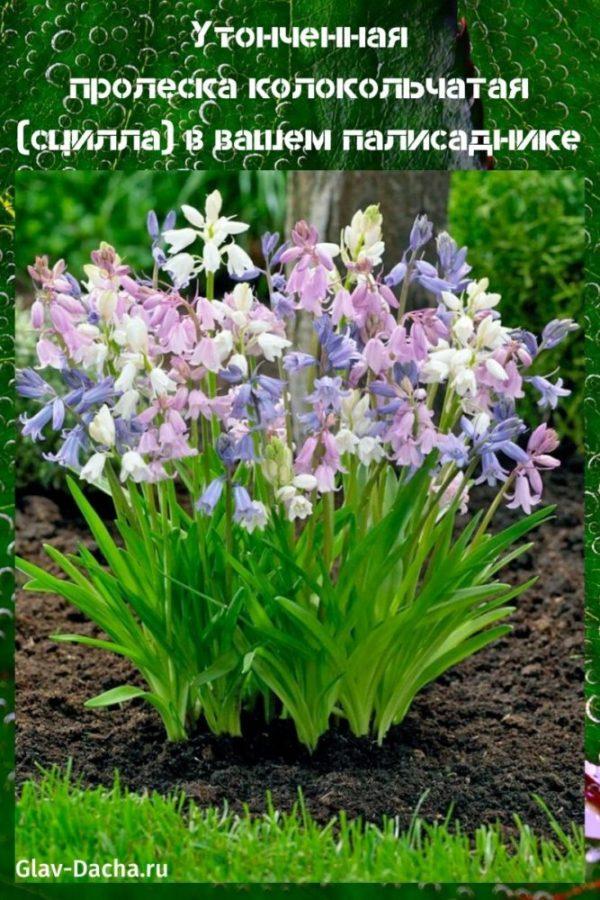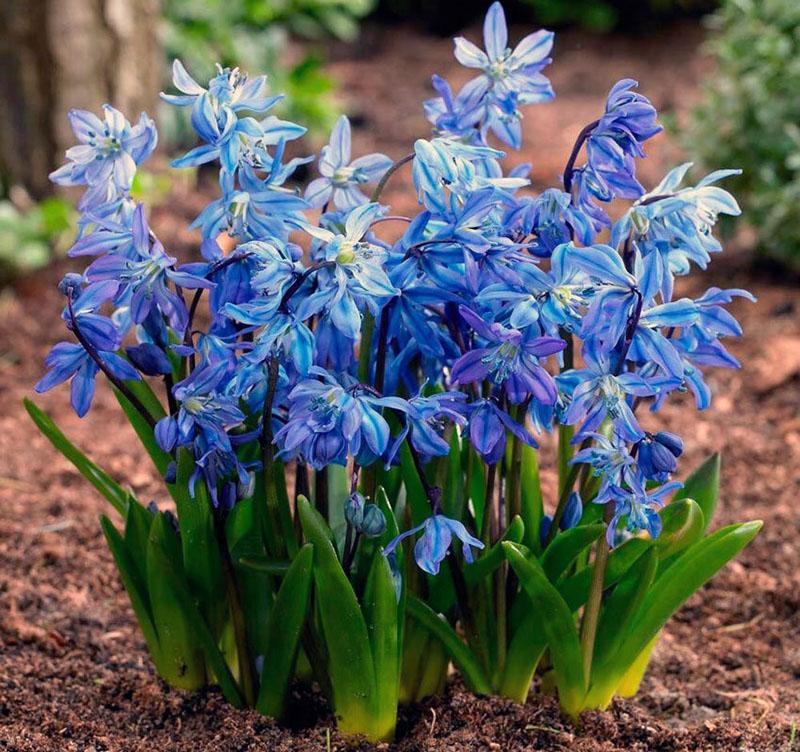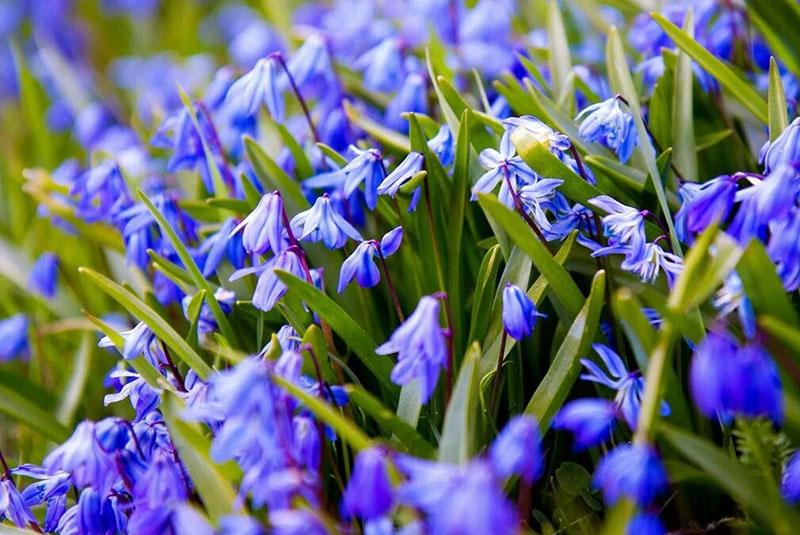Refined scilla bell-shaped (scylla) in your front garden
 An indispensable harbinger of spring has always been and will be the bell-shaped screech, enchanting with its sophistication. Cornflower blue miniature flowers fit luxuriously into the spring landscape of the garden. Delicate "bouquets", wrapped in dark green foliage, harmonize with the first rays of warm sunlight. In order for this perennial to take pride of place in the flower bed, it is necessary to learn all the subtleties of planting and caring for it.
An indispensable harbinger of spring has always been and will be the bell-shaped screech, enchanting with its sophistication. Cornflower blue miniature flowers fit luxuriously into the spring landscape of the garden. Delicate "bouquets", wrapped in dark green foliage, harmonize with the first rays of warm sunlight. In order for this perennial to take pride of place in the flower bed, it is necessary to learn all the subtleties of planting and caring for it.
Bell-spade in all its splendor

The main features of the bell-shaped woodland are:
- high decorativeness;
- extraordinary frost resistance;
- the ability to adapt to abnormal conditions;
- disease resistance.
 The average height of the crop is 30-35 cm. However, cultivars have been found that reached almost 1 m. The thin filamentous leaves of the woodland have a rich green hue and serve as an ideal background for bright blue bells. Several peduncles grow from the root outlet. They have small buds, collected in racemose inflorescences.
The average height of the crop is 30-35 cm. However, cultivars have been found that reached almost 1 m. The thin filamentous leaves of the woodland have a rich green hue and serve as an ideal background for bright blue bells. Several peduncles grow from the root outlet. They have small buds, collected in racemose inflorescences.
In addition to the blue woodland, there are other varieties:
- white;
- blue;
- purple;

- pink.
Usually, the Scylla blooms in early spring. However, in some species, this period occurs in late summer or early September.
 Round, ovoid bulbs are a distinctive feature of the bell-shaped scylla. Planting and caring for the plant is as simple as possible. Still, it is worth considering some of the subtleties of the procedure in order to enjoy this beauty in your flower bed for a single year.
Round, ovoid bulbs are a distinctive feature of the bell-shaped scylla. Planting and caring for the plant is as simple as possible. Still, it is worth considering some of the subtleties of the procedure in order to enjoy this beauty in your flower bed for a single year.
Landing woodlands, everything from A to Z
 Many gardeners use the spit as a decorative border decoration or mixboards... In some cases, the perennial culture fits perfectly into the rich exterior of the alpine slides. Another interesting solution would be to plant a scilla around the trunk of fruit trees in the garden.
Many gardeners use the spit as a decorative border decoration or mixboards... In some cases, the perennial culture fits perfectly into the rich exterior of the alpine slides. Another interesting solution would be to plant a scilla around the trunk of fruit trees in the garden.
Different seasons are suitable for this event:
- primroses are planted in the second half of summer so that they have time to take root before the temperature drops;
- autumn varieties - in late spring or mid-June, after the leaves die off;
- varieties blooming in spring - a month before the appearance of peduncles;
- other species - during the flowering period.
For a perennial, both partial shade and a shaded area in the front garden are ideal. But some autumn-flowering varieties are planted only in the shade, while Pushkinia needs a well-lit place.
 A suitable place is prepared before planting the woods. A sufficient amount of organic matter is introduced into the soil. Deciduous humus is also added and mineral fertilizers... A prerequisite for growing Scylla is a soil substrate, which should consist of 50% forest soil. It is the presence of tree bark and decayed foliage that has a beneficial effect on the development of flower culture.
A suitable place is prepared before planting the woods. A sufficient amount of organic matter is introduced into the soil. Deciduous humus is also added and mineral fertilizers... A prerequisite for growing Scylla is a soil substrate, which should consist of 50% forest soil. It is the presence of tree bark and decayed foliage that has a beneficial effect on the development of flower culture.
The acidity of the soil must also be suitable. Gardeners recommend choosing areas with a pH of 6.5-7.
Agrotechnics of planting
 First, proper site preparation is organized. In addition to fertilizers, sand is necessarily introduced into heavy soil.The acidity of the soil is regulated by adding dolomite flour or slaked lime to it. Loosening of the earth and removal of weeds is carried out.
First, proper site preparation is organized. In addition to fertilizers, sand is necessarily introduced into heavy soil.The acidity of the soil is regulated by adding dolomite flour or slaked lime to it. Loosening of the earth and removal of weeds is carried out.
Wells are prepared for planting bell-shaped woodlands:
- with an interval of 10-15 cm;
- up to 6-8 cm deep (or 2-3 bulb sizes);
- width from 5 cm.
 The bell-shaped screech gently plunges into the hole and is buried in. The soil surface is lightly tamped with your hands. Mulching technology is used to avoid crust formation and weeds.
The bell-shaped screech gently plunges into the hole and is buried in. The soil surface is lightly tamped with your hands. Mulching technology is used to avoid crust formation and weeds.
The quality of the cover is used:
- deciduous litter;

- dry cut grass;
- straw.
Needles are not suitable for mulching the Scylla, because it increases the acidity of the earth.
At the final stage of planting all plants, it is recommended to carry out abundant watering. Seedlings are thoroughly irrigated with settled water. When the site dries out a little, mulch is laid in an even layer.
Caring for an unpretentious perennial
 Despite the ability of the culture to grow in extreme conditions, all the rules of care must be followed to obtain unique decorative properties.
Despite the ability of the culture to grow in extreme conditions, all the rules of care must be followed to obtain unique decorative properties.
It is advisable to make top dressing in a timely manner for the bell-shaped forest:
- spring-flowering varieties are fertilized (for example, Nitrofoska) in early spring;
- autumn flowering varieties - before the ejection of peduncles, that is, in the fall;
- elements of calcium, iron, copper and magnesium are included in complex fertilizers.
 Water the planting as needed. The procedure is recommended to be performed in the morning. Weeding is carried out several times a month after moistening. The embedment depth should not exceed 25 mm.
Water the planting as needed. The procedure is recommended to be performed in the morning. Weeding is carried out several times a month after moistening. The embedment depth should not exceed 25 mm.
Reproduction - spontaneous or controlled
 The fruit capsule is formed at the end of the perennial flowering. It contains dozens of small seeds. Due to this, some Scylla varieties successfully reproduce by self-sowing. In addition, the bulbs divide uncontrollably underground, which makes the plant cramped in a confined space. For this reason, a large area in a flower bed or in a garden is given to herbaceous culture.
The fruit capsule is formed at the end of the perennial flowering. It contains dozens of small seeds. Due to this, some Scylla varieties successfully reproduce by self-sowing. In addition, the bulbs divide uncontrollably underground, which makes the plant cramped in a confined space. For this reason, a large area in a flower bed or in a garden is given to herbaceous culture.
Propagation of woodland takes place in the usual way:
- after flowering, but before the foliage dies off, bumps are dug from the ground;
- the resulting lumps are divided into separate bulbs;
- planting material is carefully selected so that there are no sick or rotten samples;
- healthy daughter bulbs are planted in a prepared front garden.

Transplantation of individual specimens is organized every 3-4 years. If the procedure is not carried out, then the flowers become noticeably smaller, and then completely cease to form peduncles.
 Seed propagation of a culture involves more painstaking procedures. As soon as the seed pods turn yellow and begin to crack, they are cut off. It mainly takes place at the end of June. Small seeds are extracted from them and sown in the prepared area. Some drive seedlings at home.
Seed propagation of a culture involves more painstaking procedures. As soon as the seed pods turn yellow and begin to crack, they are cut off. It mainly takes place at the end of June. Small seeds are extracted from them and sown in the prepared area. Some drive seedlings at home.
Seed germination is quite low. The first flowering is observed only after 3-4 years, after planting. Seedlings are transplanted only after 5 years.
Scylla siberian - one of the best varieties of Proleski
 The variety is distinguished by special decorative properties. The secret lies in the unique colors of the woodland. Ultramarine stripes are located in the center on bright blue petals with a purple tint. On close inspection, they resemble a "cat's eye". There are up to 4-5 of them in inflorescences.
The variety is distinguished by special decorative properties. The secret lies in the unique colors of the woodland. Ultramarine stripes are located in the center on bright blue petals with a purple tint. On close inspection, they resemble a "cat's eye". There are up to 4-5 of them in inflorescences.
Other perennial features:
- reaches a height of 10-12 cm;
- has broad-linear leaves of an emerald hue;
- dense flower stalks come with a purple tint.
 It is by such signs that you can recognize the Siberian Scylla. Planting and caring for this variety is no different from conventional varieties. A partial shade or sunny area is suitable for growing it.
It is by such signs that you can recognize the Siberian Scylla. Planting and caring for this variety is no different from conventional varieties. A partial shade or sunny area is suitable for growing it.
Therefore, seedlings are planted:
- under the trees;
- around shrubs;
- on open lawns;
- at the base rockeries.
 The flowering period begins in April and lasts a whole month (15-25 days). Then comes the resting phase, which lasts the whole summer. In the fall, a new process of planting bulbs, leaves and peduncles begins. During wintering, the herbaceous culture continues to develop.
The flowering period begins in April and lasts a whole month (15-25 days). Then comes the resting phase, which lasts the whole summer. In the fall, a new process of planting bulbs, leaves and peduncles begins. During wintering, the herbaceous culture continues to develop.
Siberian Proleska has several subspecies. They differ in the shade of drooping bells: white, blue, and pale pink.
The unpretentiousness of the bell-shaped woodland impresses many gardeners. Therefore, even letting everything take its course, you can get a rather spectacular flower bed in the colonial style, which is inherent in negligence and electricity.